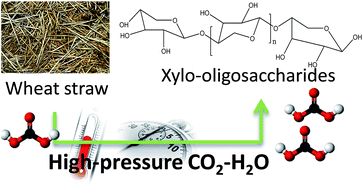Selective hydrolysis of wheat straw hemicellulose using high-pressure CO2 as catalyst
Abstract
The processing of wheat straw using high-pressure CO2–H2O technology was studied with the objective to evaluate the effect of CO2 as catalyst on the hydrothermal production of hemicellulose-derived sugars either as oligomers or as monomers. Also, the reduction of the crystallinity of the cellulose-rich fraction was assessed. Over a range of reaction conditions (0 to 50 bar of initial CO2 pressure and 0 to 45 minutes of holding time, at T = 180 °C), the addition of CO2 to water-based processes led to the in situ formation of carbonic acid, which allowed us to obtain a higher dissolution of wheat straw hemicellulose. Furthermore, this approach led to a xylo-oligosaccharide (XOS) rich fraction, yielding 79.6 g of XOS per 100 g of the initial xylan content (at 50 bar of initial CO2 pressure and 12 min of residence time) while the water-only process gave only 70.8 g of XOS per 100 g of initial xylan content. Furthermore, for higher pressures of CO2, a decrease in oligosaccharide content was found and was counterbalanced by production of monomer sugars, achieving a maximum of 5.7 g L−1 at the severest condition.


 Please wait while we load your content...
Please wait while we load your content...